Exclusively Pumping after a Surrogate Pregnancy
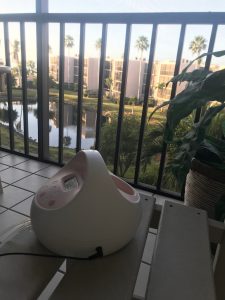 One of the many things that Heartland Surrogacy asks about when creating matches is breastmilk – do the intended parents want it and are surrogates willing to provide it? There are several options available for feeding a baby after a surrogate pregnancy; breastmilk pumped by the surrogate, breastmilk from induced lactation from an intended parent, breastmilk from a milk bank, or formula. If the lactation plan for the new baby involves breastmilk, read on! (Additionally, if you are a surrogate who would like to pump, but your IPs don’t want breastmilk, contact us for information on pumping for a milk bank.)
One of the many things that Heartland Surrogacy asks about when creating matches is breastmilk – do the intended parents want it and are surrogates willing to provide it? There are several options available for feeding a baby after a surrogate pregnancy; breastmilk pumped by the surrogate, breastmilk from induced lactation from an intended parent, breastmilk from a milk bank, or formula. If the lactation plan for the new baby involves breastmilk, read on! (Additionally, if you are a surrogate who would like to pump, but your IPs don’t want breastmilk, contact us for information on pumping for a milk bank.)
Recently, Brie Powers, President and Co-founder of Heartland Surrogacy, gave a presentation on Exclusively Pumping after a Surrogate Pregnancy at the annual Basking Babies conference. During her presentation, she was able to help educate local lactation consultants on the unique experiences surrogates encounter when exclusively pumping. Below, we have included a summary of her presentation.
Before Birth
During the initial match meeting, Heartland Surrogacy will help the intended parents and surrogate discuss their expectations regarding breastmilk. However, this meeting takes place a year or more before the birth, so it’s important to discuss intentions again in the months leading up to the birth. Some questions to consider include:
- Do the intended parents want the surrogate to breastfeed or pump in the hospital?
- How long do the intended parents foresee wanting breastmilk?
- How long does the surrogate think she will want to provide breastmilk?
- If the surrogate and IPs are local to each other, how often will they meet to pick up the milk?
- If they’re not local, how often will you ship?
It’s important to realize the time and effort that a surrogate will put into pumping breastmilk and to decide on a level of compensation that all parties are comfortable with. Many surrogates will be paid weekly for pumping, while others are paid per ounce. While compensation is typically about $250/week or $1/ounce, some surrogates will provide breastmilk for their intended parents for less. In addition to the compensation, all supplies and shipping costs should be reimbursed by the IPs. The terms of compensation for pumping breastmilk are often discussed during contracts. If they are not, a simple addendum to the contract can be added later on.
While the intended parents are getting their nursery ready and picking out a name, a surrogate who is planning to pump should be getting her pump and supplies ready to go. With exclusively pumping, it is important to have a good pump – a hospital grade pump if possible. These can usually be rented from a hospital or there are options for purchase. There are several online sites you can order a pump from using your health insurance, such as Edgepark or Aeroflow.
Additionally, the following supplies can be helpful:
- Breastmilk storage bags
- Nipple lubricant or coconut oil
- Hands free pumping bra(s)
- At least 3 sets of parts for your pump and extra bottles
- Bottle brushes and a drying rack
- If you’re pumping for a milk bank, or want to sterilize your parts regularly, an electric sterilizer such as the Wabi is essential.
- You will need to replace your pump parts every few weeks if you are pumping frequently!
Pumping
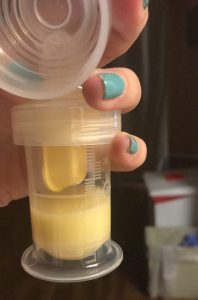 When exclusively pumping after a surrogate pregnancy, there can be both physical and emotional challenges. For many women, their body will respond to pumping differently that it does to directly breastfeeding a baby. Sometimes, milk can be slow to come in, in the days after delivery, which can be frustrating when you pump and see little to no results. Sticking with a schedule is very important. Mimicking how often a baby would eat and pumping every 2-3 hours for about 30 minutes each time is a good schedule to start with. Over time, you can spread out your pumping sessions, just as a baby would spread out how often they eat. Using a heating pad, breast massage, and sounds of a baby crying can help increase milk supply. Additionally, getting proper rest and nutrition can help immensely.
When exclusively pumping after a surrogate pregnancy, there can be both physical and emotional challenges. For many women, their body will respond to pumping differently that it does to directly breastfeeding a baby. Sometimes, milk can be slow to come in, in the days after delivery, which can be frustrating when you pump and see little to no results. Sticking with a schedule is very important. Mimicking how often a baby would eat and pumping every 2-3 hours for about 30 minutes each time is a good schedule to start with. Over time, you can spread out your pumping sessions, just as a baby would spread out how often they eat. Using a heating pad, breast massage, and sounds of a baby crying can help increase milk supply. Additionally, getting proper rest and nutrition can help immensely.
While most women expect some physical challenges, the emotional challenges of pumping take many surrogates by surprise. Surrogates pumping for their surrobabe (or surrobabies!) may feel pressure to produce enough. Again, women’s bodies respond differently to pumping, so while a woman may have nursed her own children without problems, she may struggle to pump enough to feed the baby(ies). Other women may produce significantly more than one baby needs, but still feel a pressure to maintain supply so they can build up a stash or donate to a milk bank and “feed all the babies.” Some surrogates also feel guilty about the amount of time that pumping takes them away from their family, possible missed activities, or the awkwardness of pumping in public (and the questions that come with it!) without a baby around to feed. As in typical breastfeeding situations, there are also significant hormonal changes that can have an effect on emotions.
Regardless of whether a surrogate is experiencing physical challenges, emotional challenges, or both, finding support from other surrogates who exclusively pumped can be helpful. Heartland is happy to connect our surrogates with others who have experience. There are also several relevant groups on Facebook, such as “Exclusively Pumping after a Surrogate Pregnancy” or “Surrogates Pumping Milk.” (These groups are generally private. Some of our staff have pumped after a surrogacy pregnancy and are members. Please contact us if you wish to be added!) If you feel that you need more assistance than a support group can offer, we can make recommendations for an IBCLC (International Board Certified Lactation Consultant) for additional help.
Freezing and Shipping
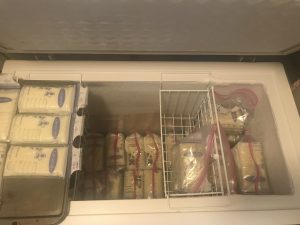 Unless the surrogate and IPs are local to each other and breastmilk is being picked up every few days, it won’t take long before a surrogate’s freezer will start filling up. These tips for freezing and storing breastmilk efficiently can help:
Unless the surrogate and IPs are local to each other and breastmilk is being picked up every few days, it won’t take long before a surrogate’s freezer will start filling up. These tips for freezing and storing breastmilk efficiently can help:
- Don’t overfill the breastmilk storage bags. They freeze the flattest with about 4-5oz/bag.
- Freeze the bags lying flat on a cookie sheet or even between two cookie sheets.
- Once frozen, the breastmilk storage bags can be stored as “bricks” – 12-15 bags in a gallon-sized, flat-bottomed zipper bag.
Check out this video to see how Surrogate Anna packed milk to send to the baby girl she carried for fathers Andrew and Jeramie.
When it is time to ship, make sure the milk is tightly packed in an insulated cooler and box. Depending on how far you’re shipping, the method of shipping you choose (overnight, 1-day, or 2-day), and the time of year, you may or may not need to use ice packs or dry ice. Many surrogates find that milk coming from a deep freeze will stay frozen, even without additional ice, if the cooler is very tightly packed and arrives within 24-48 hours.
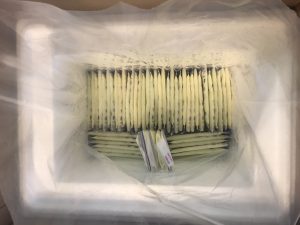
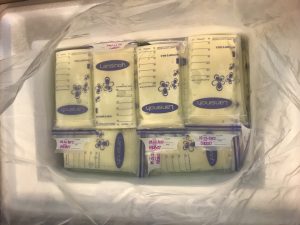
As with other supplies for pumping, any expenses related to shipping should be paid for, or reimbursed, by the IPs. To simplify the process, many IPs will order supplies online, such as breastmilk storage bags, cooler boxes, and ice packs, and have them shipped directly to the surrogate. Some shipping companies, such as FedEx or UPS, will allow IPs to set up a billing account that can be used by the surrogate to ship the milk.
Weaning
The process of stopping pumping, or weaning, can take time. Because there is no baby to slowly spread out feedings or eat less per feeding, the surrogate has to be intentional about reducing pumping time. This is best done over the course of a few weeks, or sometimes months if the surrogate is an overproducer. If done too quickly, weaning can result in clogged ducts or mastitis.
Products such as “No More Milk Tea,” Sudafed, Ibuprofen, ice, peppermint oil, and cabbage leaves can help reduce production and relieve discomfort during the weaning process.
Regardless of whether a surrogate pumps for just a few weeks, a few months, or even more than a year, pumping often feels like a continuation of her surrogacy journey. She is able to continue to provide for her surrobaby or other babies while aiding in her own recovery. Heartland Surrogacy aims to offer support through every step of the journey for surrogates and intended parents alike. If you have any questions about pumping or feeding your newest addition, contact us today!
